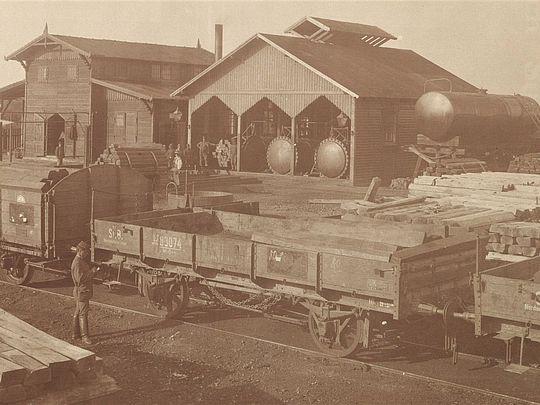

The observer of a German reconnaissance plane demonstrates the handling of a camera. The picture was taken in a flying school. Photo: Süddeutsche Zeitung Photo, 00472611 | Scherl
Environmental history
Training the Eye
The Deutsches Museum collected aircraft, airborne cameras, and imagery that make it possible to experience the history of the “view from above.” This project analyzes the infrastructures necessary to realize aerial views at the beginning of the 20th century. The results will be shown in the future exhibition “Historical Aviation up to 1918.”
Content
Training the Eye: The first experimentation phase of aerial photography until 1918.
- Environmental history
- Forschung
- Museum
- Man and Enivronment
Edited by
Dr. Noemi Quagliati
Postdoctoral Guest Researcher
Andreas Hempfer
Curator
Dr. Charlotte Holzer
Wissenschaftliche Mitarbeiterin
Project description
Focusing on aerial photo-optical devices (panoramic cameras, pigeon cameras, glass plate aerial cameras, machinegun training cameras, survey serial frame cameras), photographic techniques (stereoscopy and photomosaic mapping) and visual deception (camouflage), this project investigates how the aerial view challenged military and scientific activity while remodeling civilians’ perception and conception of the landscape.
Further project description
“It is not correct to speak of aerial imaging facilities for the period before May 1915. No doubt that photos were already taken from the balloon and the airplane, but one did not yet produce image reports in the sense that had become common for all observers during the war.” With these words, German photo officer Carl Fink described the institutionalization of aerial photography as a military discipline in World War I. This project follows the circumstances that led to the transformation of aerial photography into a systemic method of scientific surveying and imagery intelligence. Epistemological implications and public reception of aerial photography are explored through the material, animal, and technological features of aerial infrastructures. At the beginning of the 20th century, airborne photographic systems employed pigeons, kites, balloons, rockets, and airships. Through a process of trial and error, aerial photography became then effective with the development of the airplane. A public “training of the eye” accompanied the evolution of aerial photographic technology. At the beginning of the 20th century, the increasing publication and explanation of aerial photos helped civilians assimilate the world from above and interpret the landscape through verticalization, objectification, functionality, measurability, and detachment.
Presentations
- Riverside, USA (online), California Museum of Photography Conference »Camera-Centered Histories of Photography«, 02. December 2022: The Distant View Draws Closer: The Technological and Animal Infrastructure of Drone and Pigeon Photography.
- Munich, Kerschensteiner Kolleg of Deutsches Museum, Artefacts XXVII »Objects of Science and Technology in Motion«, 17. October 2022: Biography of a Film Mapping Camera for an Interpretation of Aerial Photography In-and-outside Museums of Science and Technology.
- Munich, Rachel Carson Center in cooperation with the University of Heidelberg, Methodological Workshop »After the Crisis? Rethinking Processes and Potentials of Change in Environment and Society«, 22. July 2022: The Birdscape of the Venetian Lagoon: Reflecting on the Bird’s Eye View between Art History and Animal Studies.
- Stuttgart, 36. Deutscher Kunsthistorikertag »Forum Topografische Bildmedien«, 23. March 2022: „Der Reihenbildner: Der fliegende Kino“. The Static Totality of WWI Aerial Photomontage.
- Cracow, Pedagogical University, Annual Conference of the Herder-Forschungsrats »Public History. Political Formation, Cultural Praxis and History as Science«, 26. November 2021: Aerial Photography and Public Memory in German and Polish Visual Cultures: Tracing the History of Two Photographs of Frampol.
- Berlin (online), Network Topographic Visual Media »Pasted Topographies«, 18. November 2020: The Photomosaic Map, also known as the WWI Flying Cinema.
- Milan, Fondazione Stelline, SHOT Annual Meeting »Exploring the Interface between Technology, Art, and Design«, 26. October 2019: Exchanging Perspectives Between Avant-Garde Aesthetics and Military Aerial Technology.
- Katowice, University of Silesia, ICOHTEC 46th Symposium »Technology & Power«, 24. July 2019: The Power of the Artificial Eye: Production and Reception of Aerial Photography during the World Wars.
- Berlin (Online), Network Topographic Visual Media »Pasted Topographies«, 18. November 2020: The Photomosaic Map, also known as the WWI Flying Cinema.
- Katowice, University of Silesia, ICOHTEC 46th Symposium »Technology & Power«, 24. July 2019: The Power of the Artificial Eye: Production and Reception of Aerial Photography during the World Wars.
- Milan, Fondazione Stelline, SHOT Annual Meeting »Exploring the Interface between Technology, Art, and Design«, 26. October 2019: Exchanging Perspectives Between Avant-Garde Aesthetics and Military Aerial Technology.
Publications
Quagliati, Noemi: Flying Filming: Der Reihenbildner and Aerial Photomontage, in: Pasted Topographies, Boskamp, Ulrike et al. (Hrsg.) Terrain. Studien zu topografischen Bildmedien (2023), Nr. 1, S. 157–190.
https://doi.org/10.11588/arthistoricum.1323.c18469- Quagliati, Noemi: Histoire des appareils photographiques aériens. L’exposition Historische Luftfahrt bis 1918 et les collections insulaires du Deutsches Museum, Munich, in: L'image verticale. Politiques de la vue aérienne, Sandoz M.; Weber A. (Hg.) Transbordeur. Photographie, Histoire, Société (2022), Nr. 6, S. 98-111. https://transbordeur.ch/fr/2022/histoire-appareils-photographiques-aeriens-deutsches-museum/
- Quagliati, Noemi: Playing Hide-and-Seek in the German Press: Presence and Absence of Camouflage in WWI Narrations, in: Vulcan (Brill) The Journal of the History of Military Technology (2022), Nr. 9, S. 18-49. https://doi.org/10.1163/22134603-09010003
- Quagliati, Noemi: Training the Eye: Production and Reception of Aerial Photography during the World Wars, in: AUC Geographica 55 (2020), Nr. 1, S. 93-111. https://doi.org/10.14712/23361980.2020.6
- Quagliati, Noemi: Rezension zu: Marco Rasch: Das Luftbild in Deutschland von den Anfängen bis zu Albert Speer. Geschichte und Rezeption des zivilen „Stiefkindes der Luftfahrt“. Paderborn 2021. in: H-Soz-Kult, 21.03.2023, www.hsozkult.de/publicationreview/id/reb-99014
Blog
Dietl, Tatjana; Holzer, Charlotte; Quagliati, Noemi “Fliegende Kameras: Luftbildfotografie in der Dauerausstellung ‘Historische Luftfahrt bis 1918’.” In: Der Blog des Deutschen Museums, 2021, Upcoming.
Photo gallery
Further links
[Translate to English:] Digitalisierte Luftbildkameras
https://digital.deutsches-museum.de/item/56011/#0002[Translate to English:] Digitalisierte Luftbildkameras
https://digital.deutsches-museum.de/item/53200T1/[Translate to English:] Luftbildausstellung
https://www.deutsches-museum.de/museum/aktuell/ein-anderer-blick-aufs-wasser[Translate to English:] Luftbildausstellung
https://www.deutsches-museum.de/flugwerft-schleissheim/ausstellung/sonderausstellungen/uebersicht/habitat


![[Translate to English:] [Translate to English:]](/assets/_processed_/f/a/csm_Forschung_Projekt_RCC2_4949d83dc2.jpg)